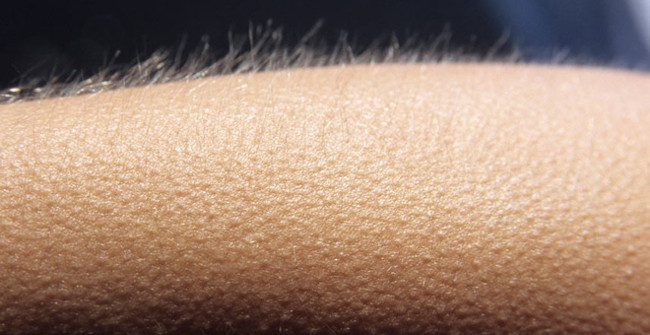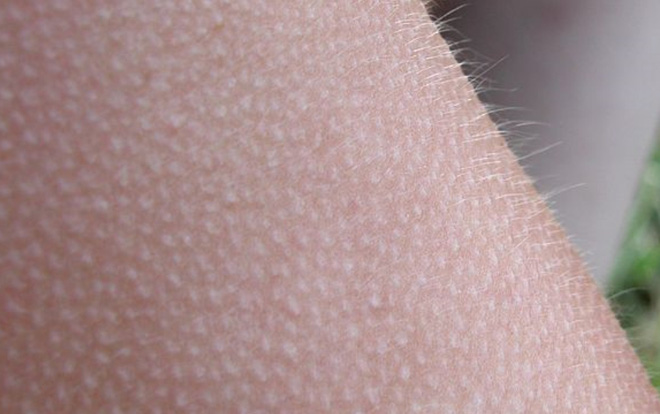This is the only part of the body that never 'goosebumps'.
Floating goose bumps, also known as prickly, floating spines are normal physiological phenomena of the body whenever people are cold or frightened . tiny tiny spots floating on the skin that look like bumps after when plucked.
- 5 parts of new scientific world discovered in human body
- The human body changes throughout life but only one part does not change, you know what it is?
- In the future, these excess body parts may completely disappear due to evolution
We have only one part of the body that is "immune" to this phenomenon. And do you know which part it is?

When we are cold or intense emotions will stimulate the sympathetic part of the autonomic nervous system - the part that is responsible for maintaining the body's physiological balance, producing adrenaline hormones - causing small muscles Connected to the subcutaneous hair follicle on the body shrinking, the skin surface around the hair shrinks and slightly drops. At that time, the hairs, hairs and legs are more visible and goosebumps occur.

These hair follicles appear everywhere on our bodies. But we will not be able to observe the phenomenon of goosebumps in some parts, typically in the face area.
The reason is that the area between the hairs is very small. When the hair-raising muscle shrinks, the skin also pulls down, but due to the area of the skin between the small hairs, the phenomenon of goose bumps occurs not as clearly as in the arms and legs.

In addition, there is another explanation for this phenomenon. It is the expression of facial expressions that require the coordination of a lot of muscles under the skin. These expressive muscles work so hard that it is difficult to recognize the presence of goose bumps on our faces.
This shows how great our body is an 'apparatus'. Surely no one wants to have a bump on his face, that's too horrible.
You should read it
- 14 body signs show that you are not really as healthy as you think
- 7 kinds of fruit juices help you to have bright and smooth white skin
- 5 bad habits make your hands older than your face to 10 years old
- 8 abnormal signs on the skin warning the body is having serious health problems
- How to boil delicious and beautiful chicken, no crack
- How to mod Minecraft PC skin easily
- 7 scientific tips that help goodbye wrinkles effectively
- How to change the skin in Among Us
May be interested
- A simple way to help your body retain its natural fragrance all day long
 summer is hot, making the sweat glands work a lot, losing your confidence when you hang out and interact with friends. in addition to ways to beautify the visual sense through clothes, makeup, and body. then there is a very special thing not everyone knows and focuses on. it is a natural fragrance on the body that anyone owns.
summer is hot, making the sweat glands work a lot, losing your confidence when you hang out and interact with friends. in addition to ways to beautify the visual sense through clothes, makeup, and body. then there is a very special thing not everyone knows and focuses on. it is a natural fragrance on the body that anyone owns. - How to detox your body after eating and drinking too much during Tet holiday
 after a week of holiday binge eating and partying, it's time to get back to normal. here's how to detox your body and get back in shape for the new year after a week of tet.
after a week of holiday binge eating and partying, it's time to get back to normal. here's how to detox your body and get back in shape for the new year after a week of tet. - Ways the body communicates with us that are often overlooked
 our bodies are machines, constantly sending signals and messages, but we rarely pay attention to them. let's see what our bodies want to tell us through the signals below.
our bodies are machines, constantly sending signals and messages, but we rarely pay attention to them. let's see what our bodies want to tell us through the signals below. - What happens to the body when you fall in love?
 when you look at someone you love, chemicals are released in your body that cause your heart to beat faster and your pupils to dilate. if you've ever been in love, you'll be familiar with these signs.
when you look at someone you love, chemicals are released in your body that cause your heart to beat faster and your pupils to dilate. if you've ever been in love, you'll be familiar with these signs. - 18 interesting facts about the human body that make you say 'miraculous'
 check out the 18 interesting facts about the human body that make you wonder how to say it below, ensuring you will be extremely surprised to see!
check out the 18 interesting facts about the human body that make you wonder how to say it below, ensuring you will be extremely surprised to see! - What is the normal body temperature? What temperature is abnormal need to see a doctor?
 if the body temperature rises too high, it will greatly affect the health status of people. so, what is the normal body temperature and how much is the abnormal temperature?
if the body temperature rises too high, it will greatly affect the health status of people. so, what is the normal body temperature and how much is the abnormal temperature? - Method to help eliminate toxic body, everyone should know
 every day our body absorbs a lot of toxins into the body, causing the body's resistance to be reduced, which can easily cause the illness. in order to overcome this situation, we need methods to detoxify the body.
every day our body absorbs a lot of toxins into the body, causing the body's resistance to be reduced, which can easily cause the illness. in order to overcome this situation, we need methods to detoxify the body. - 8 facts about male bodies that they themselves do not know
 let's tipsmake.com learn 8 facts about male body that they themselves do not know in the article below!
let's tipsmake.com learn 8 facts about male body that they themselves do not know in the article below! - 8 habits that are destroying your body
 experts point out that detoxifying the body with juice, completely eliminating sugar or starch, skipping breakfast... are habits that seem good but are harmful to the body.
experts point out that detoxifying the body with juice, completely eliminating sugar or starch, skipping breakfast... are habits that seem good but are harmful to the body. - 10 strange things happen to the body when you fly
 here are 10 strange things that happen to the body when flying. please join us to learn carefully to have the best preparation for your vacation!
here are 10 strange things that happen to the body when flying. please join us to learn carefully to have the best preparation for your vacation!










 Exotic metal knows 'transformations' back to the original shape no matter how deformed
Exotic metal knows 'transformations' back to the original shape no matter how deformed Discover the secret behind the 'horror' sword swallowing magic
Discover the secret behind the 'horror' sword swallowing magic Why is Friday 13th considered 'unlucky day'?
Why is Friday 13th considered 'unlucky day'? 6 habits millions of people are doing wrong every day without realizing
6 habits millions of people are doing wrong every day without realizing Close up of the scene of the horrifying explosion of the super volcano, engulfing the whole city
Close up of the scene of the horrifying explosion of the super volcano, engulfing the whole city How does human body change in Mars?
How does human body change in Mars?